The Morning Blend
6 Steps to Better Local SEO
Optimizing your business for local search is the fastest, cheapest way to get on Google's radar. Here's how to do that.
Let’s face it. You probably don’t need a fancy website with a ton of bells and whistles designed to skyrocket you to national prominence.
No.
If you’re like most of our customers, you’re primary marketing goal is to grow your business locally. To increase your local customer base. And maybe to avoid having to spend so much time hunting for new business.
First, the bad news.
The bad news is that you will likely never have to stop selling. It’s an important part of every small business owner’s job…whether they like it or not.
But, the good news is that with the right local SEO, you can probably spend a little less time hunting and a little more time working on the business. Or with your family. Or both.
If you want to nail local marketing, here’s what you need to do.
Download our Free 6-Step Local SEO Plan for a comprehensive guide on how to get your business to show up in Google for more local customers. Local SEO the quickest, fastest way to get on Google’s radar.
Step 1: Optimize Your Google Local Profile
This is one of the first things you need to do.
Let’s take a quick look at a local search result. Note: this is on desktop, not mobile, but it’s not dramatically different.
The first thing you’ll notice, of course, are ads. There will be another post on this forthcoming.
But, below the ads, you’ll notice a local map.
Then a section with a list of local companies, their location on a map, and, if you click, a link to their Google profile.
These profiles are above what most people think of as the top spots.
And a lot of people click on them when searching for local business because, well, it’s easy. And they don’t like to scroll too much.
Filling Out Your Profile
To optimize your profile, you first want to head over to Google My Business and create an account.
Then, click on “Info” and fill out your profile.
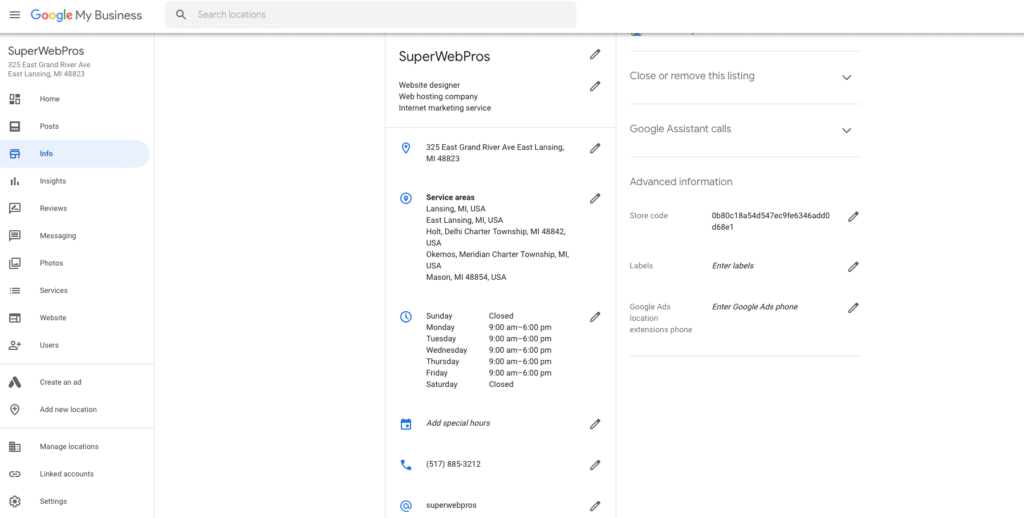
You’ll want to focus on a few key areas:
- Your business categories
- Your business location (make sure it matches up with your website!)
- Your service areas
- Your business hours
- Your contact information
- Your business description
- Photos
Of course, the more you fill out, the better. But these first few things are essential.
Step 2: Get Reviews
You’ll notice underneath the names of the companies referenced in the video above are reviews.
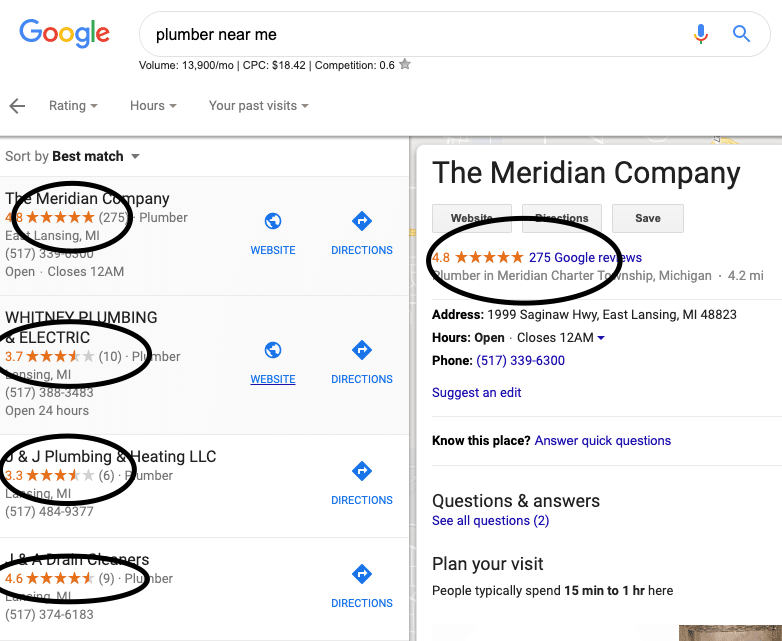
Reviews are really valuable.
They’re also challenging to get.
But, the more – and higher – ratings you get, the easier it is to rank locally.
Intuitively, this makes sense. Google’s whole raison d’etre is to return relevant results for the things people are searching for. So, if you have a lot of reviews in a category people are searching for…then, Google will return them.
Respond to Reviews
As you get reviews, they’ll populate the “Reviews” section of your Google profile.
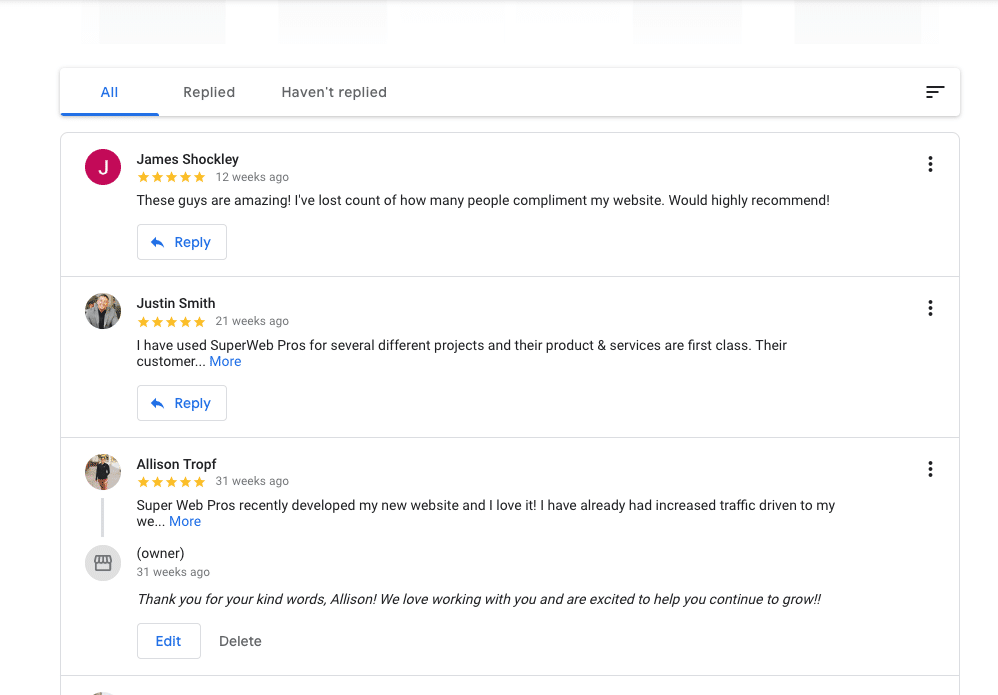
Engaging with reviews is a great way to show your customers (who took the time to review you!) that you are grateful for their feedback, but also shows Google that you’re paying attention to your online presence.
If someone leaves a poor review, it also gives you a public forum to make it right. Or, at the very least, show people how you handle critical feedback.
Step 3: NAP Consistency with Local Citations
No, we don’t mean sleep more.
Although, many business owner’s don’t sleep enough. And good sleep is important.
No, we mean your Name, Address, and Phone Number should be consistent across Google, your website, and any other directories (e.g., Chamber of Commerce, Manta, etc) you’re a part of.
Think of that trifecta of data as a unique identifier that authenticates who you are.
The more places with that information maintained across platforms, the easier it is for Google’s index to recognize a) that your information is accurate, b) that your information is consistent, and c) that you are actively engaged online.
(As an aside, part of our local business web design service includes coordinating NAP across several local directories.)
Step 4: Optimize Your Website for Local SEO
While having a good Google profile matters, having a great website is still important for local SEO.
In fact, you’ll notice that many of the Google profiles have a little “Website” button next to their profile.
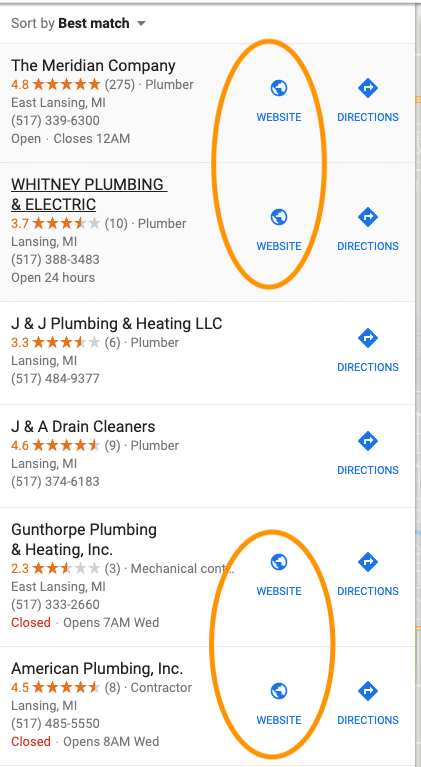
People click those buttons.
After you show up and they see you have good reviews, the next question in a customer’s head is often “But, can they help me?“
So, they click on the website to see what services you offer, what you charge, and whether there might be a good fit.
Then, they’ll reach out via phone or live chat – maybe a contact form. But most likely not.
Make Sure Your Website is Fast
We’ve written before about much your website’s speed matters for ranking.
Don’t want to read the post? This 1 minute video sums up the key points:
Over 60% of all Internet searches take place on a mobile device and Google is in the business of creating great user experiences. That means they don’t like it when people get frustrated waiting for their websites to load.
Even though my whole generation remembers having to wait *gasp* minutes for pages to load (remember when 14.4, 28.8, and 56.7k modems were considered fast?! ?), we don’t like it now.
Nobody does.
So, Google penalizes sites that are slow – especially on mobile.
This is a great area of opportunity for local business websites because many of them aren’t updated regularly (shame on them!) and, as a result, have old code, plugins, or large media files that make them slowww.
Keywords Still Matter
As you continue to scroll past those local profiles on a Google search result, you’ll start to see links to local businesses.
Many of those businesses have earned their top spot because they have relevant keywords and have had them for a long time.
The truth is that having had a website for a long time is a good indicator to Google that you’ve been around – and probably will be – for some time.
You get some major juice for that.
However, with good keywords, on-page SEO, and a solid blog that focuses on things your customers care about, you could find your local business starting to climb in ranking.
Step 5: Blog
As alluded to in the previous section, a good blog can help quite a bit with local ranking.
One non-technical reason is because most of your competition isn’t doing it.
Partially because it’s hard. (Unless you rely on someone like us…we make it easy).
Maintaining a blog gives Google more content to index, you more opportunity to rank for different keywords, and provides helpful guidance to customers and prospects who are trying to figure out how to solve the problems you can help them with.
As you maintain a good blog, in concert with the other items mentioned above, you send signals to the search engines that you’re working hard to provide great service to a relevant group of customers and Google will start to recognize that.
Plus, good content gets shared, which beefs up referrals.
Step 6: Cultivate Other Local SEO Factors
Of course, nobody knows all of the factors that influence Google’s algorithm and many are probably outside of your control. However, this nifty chart by SEO company, Moz shows how much different factors influence local SEO.
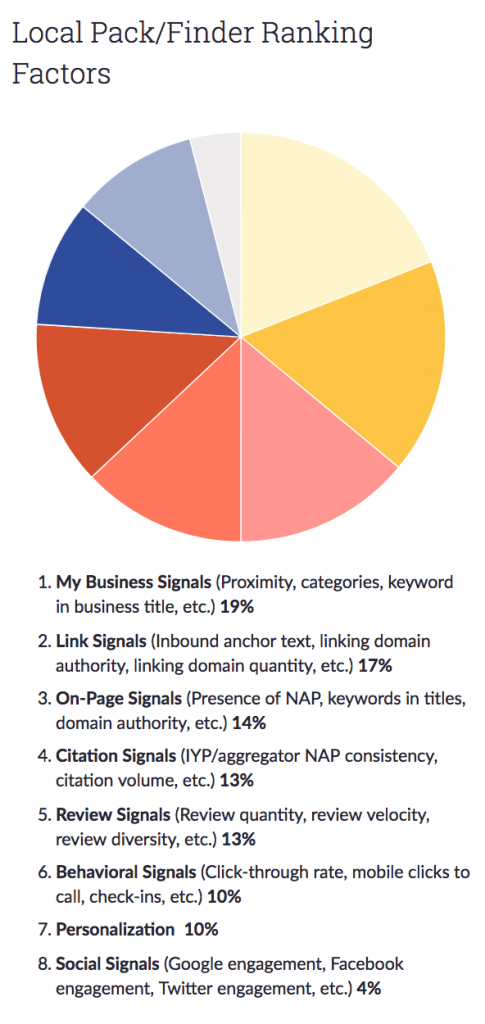
Most of what we’ve talked about address points 1 (Google Profile, Website, Blog, NAP), 3 (Website, NAP), 5 (Reviews), and 6 (Website, Mobile).
So, approximately 56% of documented signals Google looks at.
Numbers 2 & 4 make up the next 30%, but, frankly, require real work. (However, our unlimited website design package handles #4…in addition to 1,3,5, and 6).
Number 2…well, that just takes effort, a blog, outreach, and engagement. It’s all beyond the scope of this post.
Personalization (7) and Social Signals (8) each have their own challenges and are outside the scope of this post, too.
Still, just these few tips can help you manage up to 56% of the factors involved in optimizing your local SEO. Which, let’s face it, is probably more than a lot of your competition is investing.
Not sure how to get started? Reach out for a free consultation with one of our Pros to find out?!
Also from the Pros...
Why Marketing Campaigns Fail
19 Ways to Make Your Next Small Business Website Design Stand Out
8 Mobile Trends We're Watching for 2017
- « Previous
- 1
- …
- 15
- 16
- 17



